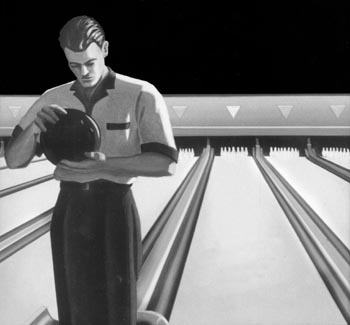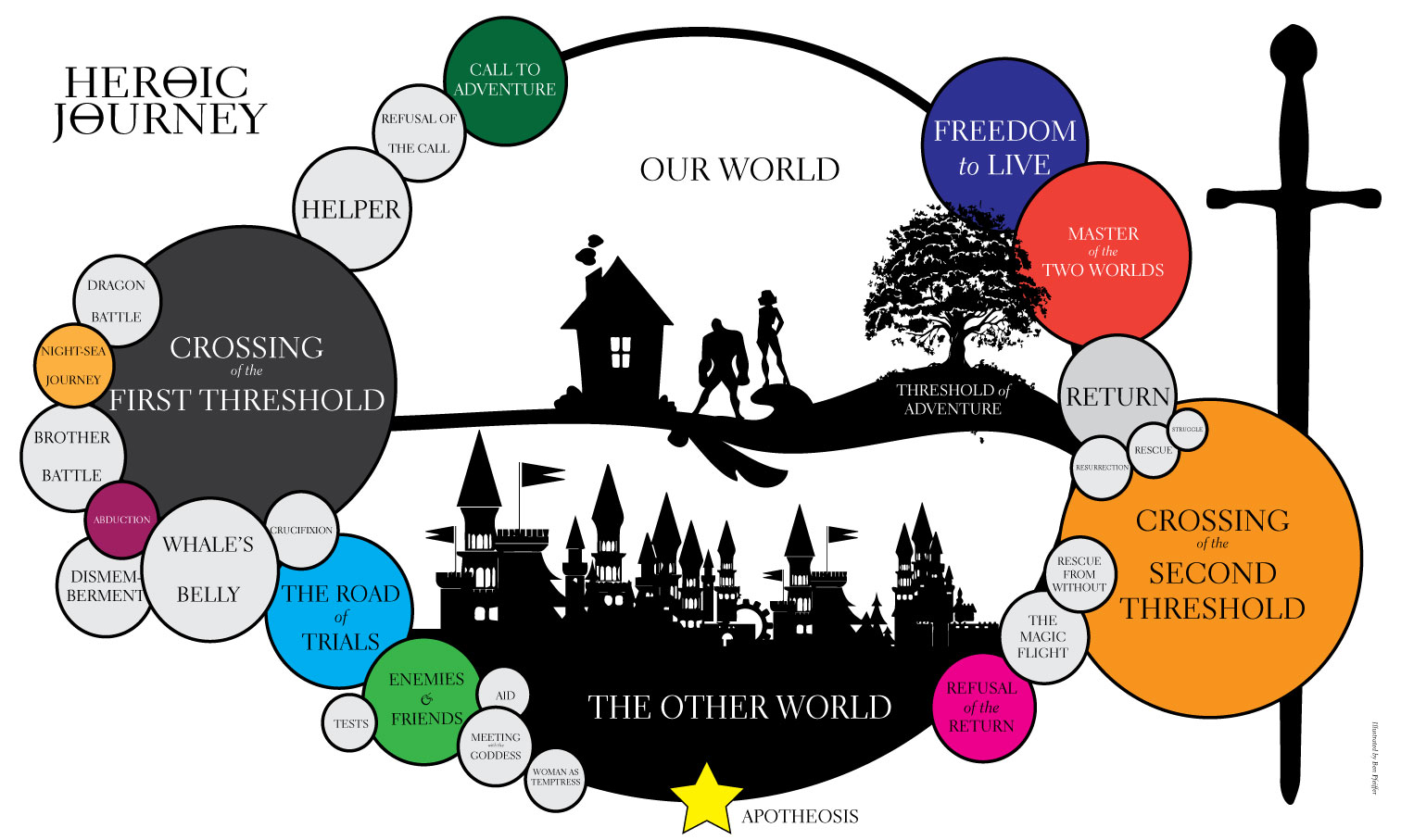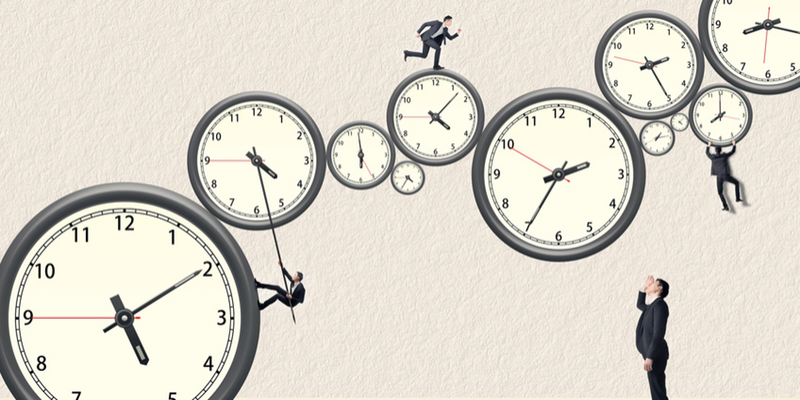by Midnight Freemason Contributor
In mythology, the monomyth or hero’s journey, is the common template of a broad category of storytelling that involves a hero who goes on an adventure, and returns a changed individual. Originally put forward by Joseph Campbell’s “The Hero with a Thousand Faces”, the monomyth can be seen illustrated time and time again in Hollywood and popular novels. While Campbell originally had 17 steps to his monomyth, subsequent authors have broken it down into more summarized variations. For the purposes of today’s article, I’ll be using the adaptation of it made by Christopher Vogler. Christopher Vogler adapted the monomyth into 12 steps. The 12 steps can be summarized best below:
ACT 1: Departure
- The ordinary world
- The call to adventure
- Refusal of the call
- Meeting with the mentor
- Crossing the threshold to the special world.
ACT 2: Initiation
- Tests, allies and enemies
- Approach to the inmost cave
- The ordeal
- Reward
ACT 3: Return
- The road back
- The resurrection
- Return with the elixir
My article today will focus on the journey of a candidate through their Masonic Degrees, and how the monomyth applies. While ACT 2 takes place during all 3 degrees, it would be my argument that ACT 1 only applies before the candidates 1st degree, and that ACT 3 only takes place during the second section of the 3rd degree.
ACT 1: DEPARTURE
The ordinary world – This is where the hero exists before his adventure begins. The hero is oblivious to the adventure to come. In general, this part of the monomyth humanizes the hero so that we can identify better with them and empathize with them during their journey. Masonically, this would be a candidate prior to petitioning a lodge.
The call to adventure – The hero’s adventure begins when they receive a call to action. This could be a threat to their safety, their family, or way of life in general. It could be as Dramatic as Luke Skywalker being shown the distress message from Leia Organa in Star Wars: A New Hope or as mundane as receiving a phone call. Masonically, this would happen when a candidate first thinks about joining the fraternity. Something causes his decision. For some of us, it could have been a friend or peer discussing Masonry. For others, it would have been a Father or Grandfather who was a Mason. Ultimately though, there is usually some outside force or circumstance which makes the candidate interested in joining Freemasonry.
Refusal of the call – The hero has second thoughts about going on the adventure. Normally the Hero will have second thoughts or be conflicted about going, often refusing the call because it’s easier to sit at home and do nothing than to undertake a perilous journey. This would be the candidate prior to petitioning the lodge. They might be interested in joining, but ultimately as I said, it’s easier to stay at home.
Meeting with the mentor – It’s at this crucial point where the Hero needs some guidance and meets a mentor figure that gives him something that they need. They could be given some item, advice, training or self-confidence. The mentor’s role is to provide the Hero with the power to overcome his refusal of the call, and help the hero begin his quest. Ultimately, this would be when a candidate petitions the lodge. They either meet with a mentor or peer, or meet with several. The candidate is ultimately given the information that was needed to make them heed their call, and to petition the lodge.
Crossing the threshold to the special world. – The Hero is now ready to begin their adventure. They may go willingly, or not, but they ultimately move from the world which is comfortable to one which is mysterious. This action ends ACT 1 and signifies the hero’s commitment to the adventure. The candidate literally undergoes this transition upon knocking three times at the door of the preparation room. They are in darkness and must commit their self to their ultimate quest, receiving the degrees of Freemasonry. They knock upon that door and once they are admitted, they cross the threshold from the ordinary to the extraordinary.
ACT 2: INITIATION
Tests, allies and enemies – The hero is confronted with a series of challenges. Obstacles are thrown in their path, and the hero must overcome them as they journey toward their ultimate goal. The hero finds out who they can trust, who they can’t and they are prepared for the challenges ahead as well. Each obstacle helps us gain insight into the hero’s character, and helps us identify with them. This takes place upon the candidate’s first entrance into the lodge. They are received in due form and is challenged by the Senior Deacon. They are lead around the lodge by the Senior Deacon and interrogated by the Junior and Senior Warden. They are also led to the Worshipful Master, who does the same.
Approach To The Inmost Cave - The inmost cave represents the location of the Hero’s ultimate challenge. As the hero approaches the cave, they may again face some doubts regarding their adventure. They may need to think about the next step, and ultimately find the strength to continue. For the candidate, this is when they make their turn to the East, their feet forming the angle of a square, standing erect before the altar. They are once again challenged to insure that their choice to approach remains the same as before.
Ordeal – The penultimate conflict that the hero faces upon their journey. It might be a physical test of strength against an enemy, or a battle of wits. The hero must draw upon everything they’ve learned up until now in order to survive the challenge. Basically, the hero undergoes a life – changing event and comes out of it a better person. Now, ultimately the oaths that a candidate takes invokes a promise of physical harm if they knowingly give away the secrets of Masonry. I think the ordeal that the candidate undergoes is an internal one, and one that they must deal with daily going forward. The process of being brought from darkness to light, is a metaphorical and philosophical ordeal. It’s a challenge to the candidate to live your life one way going forward or face penalties for not doing so. Ultimately, you are facing yourself in battle when you take your obligation, because you’re forced to choose to live by the promises you swore, or to not. You might be tested by your promises daily, or maybe never, but you always have to be aware of what they are and to honor them. Being a Freemason is a full time job because when you represent yourself going forward, you also represent your brethren. That’s the ordeal we must face not only during our obligation, but also by trying to live it daily.
Reward (Seizing the Sword) – After overcoming the adversity of the ordeal, the hero is transformed into a new state. They are battle-tested and often end up with an item of great importance as a reward. The reward might be an object of great power, or a secret, greater knowledge, or reuniting with a loved one. In all cases, the reward prepares the hero for the final leg of their journey back to the ordinary world. Ultimately, the reward given to a candidate is the password, grip or token, due guard and sign, how to wear their apron and their working tools, as well as the explanatory lectures and charges for that degree. Everything that happens after the obligation in the 1st and 2nd degrees, after the obligation to the second section in the 3rd, and after the second section of the 3rd degree, is a reward to the candidate. They are imparted with knowledge and wisdom that they did not have prior to their entry to the lodge. They were in darkness, and have been brought to light both literally and metaphorically. In our case the reward is how to act like a member of our fraternity both while in lodge and out of lodge.
ACT 3: RETURN
The road back – this represents a retracing of the hero’s steps in reverse order from Crossing the Threshold to receiving the call to adventure. As the hero’s journey draws to an end, they are now worried about adjusting back to an ordinary life in the ordinary world. However, the journey is not yet over. There are still potential challenges to overcome, and there might be a moment where the hero must choose between personal objectives or to answering to a higher cause. The best example of this would be in The Matrix, where Neo chooses to save Morpheus from the agents with the help of Trinity. This was foreshadowed by the Oracle telling him that he’d have to choose his life over that of Morpheus’s’. In the 3rd degree, this would be represented by the candidate’s journey beset with the 3 ruffians, whereby they try to pry the secrets of a Master Mason from them.
Resurrection – This is the climax of the hero having to face his final and most difficult encounter with death. The final battle represents something far greater than the Hero’s own existence with the consequences being the fate of the world or universe which hang in the balance. Ultimately the hero will vanquish evil and save the day, and will be reborn either literally or metaphorically. Think of Luke destroying the Death Star, or Neo becoming the “One”. I think this is pretty self-explanatory to those that have gone through the 3rd degree. There is a deeply moving and profound thing that happens which transforms the candidate. Since our page is not tiled, and I assume we have some EA’s and Fellowcraft as well as “Profane” readers, I’ll not elaborate further.
Return with the Elixir – This is the final stage of the Hero’s journey. The hero returns back to the Ordinary World changed. They will have grown as a person due to their experiences. They will obtain a final reward, which is either literal or metaphoric. There is a resolution for the hero, but also his allies and detractors. Ultimately, the hero is back to where they started, and nothing will be the same for them. The new Master Mason’s journey is also complete for now. They have received some final instructions, tokens, words. They are able to vote in their lodge, wear a Masonic ring, and begin a new journey to the East.
So my brothers, I ask you: Are you not also a hero? Hasn’t each of us undergone this journey during our degrees? For some of us, like myself, I am close to the end of another journey, the journey to the East as being Worshipful Master of my lodge. The most important message that I can convey is to never let your Masonic journey end. Whether it be joining appendant bodies, or going through the chairs at your own lodge, there is an opportunity for each of us to be heroes. We just need to show up and do what is needed for the betterment of our lodge, community and ourselves. If someone out there sees you being a Masonic Hero, then maybe, just maybe, they might want to set out on their own adventure, and join our league of Heroes. I believe that our greatest advertisement is what message we deliver and represent. Maybe it’s time to stop hiding and to show the world what we are really made of. If we all can be heroes, then we might just be able to make the world a better place. I, for one, believe that can be the case.
~DAL




















